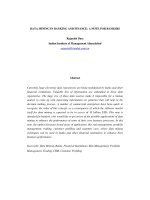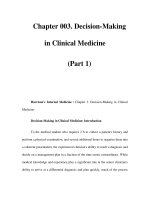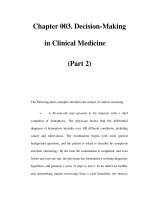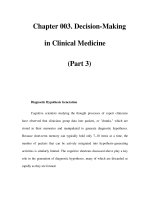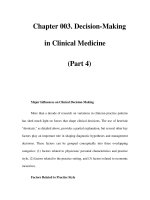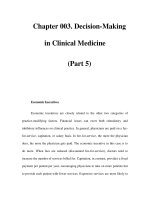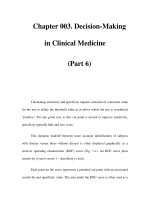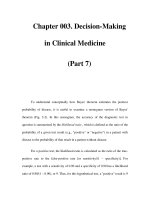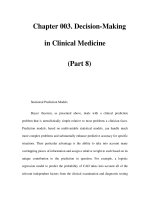Data mining in clinical medicine fernández llatas garcía gómez 2014 11 24
Bạn đang xem bản rút gọn của tài liệu. Xem và tải ngay bản đầy đủ của tài liệu tại đây (11.17 MB, 271 trang )
Methods in
Molecular Biology 1246
Carlos Fernández-Llatas
Juan Miguel García-Gómez Editors
Data Mining
in Clinical
Medicine
METHODS
IN
MOLECULAR BIOLOGY
Series Editor
John M. Walker
School of Life Sciences
University of Hertfordshire
Hatfield, Hertfordshire, AL10 9AB, UK
For further volumes:
/>
Data Mining in Clinical Medicine
Edited by
Carlos Fernández-Llatas
Instituto Itaca, Universitat Politècnica de València, València, Spain
Juan Miguel García-Gómez
Instituto Itaca, Universitat Politècnica de València, València, Spain
Editors
Carlos Fernández-Llatas
Instituto Itaca, Universitat
Politècnica de València
València, Spain
Juan Miguel García-Gómez
Instituto Itaca, Universitat
Politècnica de València
València, Spain
ISSN 1064-3745
ISSN 1940-6029 (electronic)
ISBN 978-1-4939-1984-0
ISBN 978-1-4939-1985-7 (eBook)
DOI 10.1007/978-1-4939-1985-7
Springer New York Heidelberg Dordrecht London
Library of Congress Control Number: 2014955054
© Springer Science+Business Media New York 2015
This work is subject to copyright. All rights are reserved by the Publisher, whether the whole or part of the material is
concerned, specifically the rights of translation, reprinting, reuse of illustrations, recitation, broadcasting, reproduction
on microfilms or in any other physical way, and transmission or information storage and retrieval, electronic adaptation,
computer software, or by similar or dissimilar methodology now known or hereafter developed. Exempted from this
legal reservation are brief excerpts in connection with reviews or scholarly analysis or material supplied specifically for
the purpose of being entered and executed on a computer system, for exclusive use by the purchaser of the work.
Duplication of this publication or parts thereof is permitted only under the provisions of the Copyright Law of the
Publisher’s location, in its current version, and permission for use must always be obtained from Springer. Permissions
for use may be obtained through RightsLink at the Copyright Clearance Center. Violations are liable to prosecution
under the respective Copyright Law.
The use of general descriptive names, registered names, trademarks, service marks, etc. in this publication does not
imply, even in the absence of a specific statement, that such names are exempt from the relevant protective laws and
regulations and therefore free for general use.
While the advice and information in this book are believed to be true and accurate at the date of publication, neither
the authors nor the editors nor the publisher can accept any legal responsibility for any errors or omissions that may be
made. The publisher makes no warranty, express or implied, with respect to the material contained herein.
Printed on acid-free paper
Humana Press is a brand of Springer
Springer is part of Springer Science+Business Media (www.springer.com)
Preface
Data mining is one of the technologies called to improve the quality of service in clinical
medicine through the intelligent analysis of biomedical information. From the enunciation
of evidence-based medicine in early 1990s [1], the need for creating evidence that could be
quickly transferred to physician daily practice is one of the most important challenges in
medicine. The use of statistics to prove the validity of the treatment over discrete populations; the creation of predictive models for diagnosis, prognosis, and treatment; and the
inference of clinical guidelines as decision trees or workflows from instances of healthcare
protocols are examples of how data mining can help in the application of Evidence Based
Medicine.
The great interest that emerges from the use of data mining techniques has caused that
there was a large amount of data mining books and papers available in literature. The
majority of techniques or methodologies that are available for use are published and can be
studied by clinical scientist around the world. However, despite the great penetration of
those techniques in literature, their application to real daily practice is far to be complete.
For that, when we were planning this book, our vision was not just to compile a set of data
mining techniques, but also to document the deployment of advance solutions based on
data mining in real biomedical scenarios, new approaches, and trends.
We have divided the book into three different parts. The first part deals with innovative
data mining techniques with direct application to biomedical data problems; in the second
part we selected works talking about the use of the Internet in data mining as well as how
to use distributed data for making better model inferences. In the last part of the book, we
made a selection of new applications of data mining techniques.
In Chapter 1, Fuster-Garcia et al. describe the automatic actigraphy pattern analysis for
outpatient monitoring that has been incorporated in the Help4Mood EU project for helping people with major depression recover in their own home. The system allows the reduction of inherent complexity of the acquired data, the extraction of the most informative
features, and the interpretation of the patient state based on the monitoring. For this, their
proposal covers the main steps needed to analyze outpatient daily actigraphy patterns for
outpatient monitoring: data acquisition, data pre-processing and quantification, non-lineal
registration, feature extraction, anomaly detection, and visualization of the information
extracted. Moreover, their study proposes several modeling and simulation techniques useful for experimental research or for testing new algorithms in actigraphy pattern analysis.
The evaluation with actigraphy signals from 16 participants including controls and patients
that have recovered from major depression demonstrates the utility to visually analyze the
activity of the individuals and study their behavioral trends.
Biomedical classification problems are usually represented by imbalanced datasets. The
performance of the classification models is usually measured by means of the empirical error
or misclassification rate. Nevertheless, neither those loss functions nor the empirical error
are adequate for learning from imbalanced data. In Chapter 2, Garcia-Gomez and Tortajada
define the loss function of LBER whose associated empirical risk is equal to the balanced
v
vi
Preface
error rate (BER). In these problems, the empirical error is uninformative about the
performance of the classifier and the loss functions usually produce models that are shifted
to the majority class. The results obtained in simulated and real biomedical data show that
classifiers based on the LBER loss function are optimal in terms of the BER evaluation
metric. Furthermore, the boundaries of the classifiers were invariant to the imbalance ratio
of the training dataset. The LBER-based models outperformed the 0–1-based models and
other algorithms for imbalanced data in terms of BER, regardless of the prevalence of the
positive class. Finally, the authors demonstrate the equivalence of the loss function to the
method of inverted prior probabilities, and generalize the loss function to any combination
of error rates by class. Big data analysis applied to biomedical problems may benefit from
this development due to the imbalance nature of most of the interesting problems to solve,
such as predictive of adverse events, diagnosis, and prognosis classification.
In Chapter 3, Vicente presents a novel online method to audit predictive models using
a Bayesian perspective. This audit method is specially designed for the continuous evaluation of the performance of clinical decision support systems deployed in real clinical environments. The method calculates the posterior odds of a model through the composition
of a prior odds, a static odds, and a dynamic odds. These three components constitute the
relevant information about the behavior of the model to evaluate if it is working correctly.
The prior odds incorporates the similarity of the cases of the real scenario and the samples
used to train the predictive model. The static odds is the performance reported by the
designers of the predictive model and the dynamic odds is the performance evaluated with
the cases seen by the model after deployment. The author reports the efficacy of the method
to audit classifiers of brain tumor diagnosis with magnetic resonance spectroscopy (MRS).
This method may help on assuring the best performance of the predictive models during
their continuous usage in clinical practice.
What to do when we obtain underperformed expectations of the predictive models
during their real use of predictive models? Tortajada et al. in Chapter 4 propose an incremental learning algorithm for logistic regression based on the Bayesian inference approach
that may allow to update predictive models incrementally when new data are collected or
even to perform a new calibration of a model from different centers. The performance of
their algorithm is demonstrated by employing different benchmark datasets and a real brain
tumor dataset. Moreover, they compare its performance to a previous incremental algorithm and a non-incremental Bayesian model, showing that the algorithm is independent
of the data model and iterative, and it has a good convergence. The combination of audit
models, such as the proposal from Vicente, with incremental learning algorithms, such as
that proposed by Tortajada et al., may help on the assurement of the performance of clinical
decision support systems during their continuous usage in clinical practice.
New trends like interactive pattern recognition [2] aim at the creation of human understandable data mining models allowing them the correction of the models to make a direct
use of data mining techniques as well as facilitate its continuous optimization. In Chapter
5 new possibilities about the use of process mining techniques in clinical medicine are presented. Process mining is a paradigm that comes from the process management research
field and that provides a framework that allows to infer the care processes that are being
executed in human understandable workflows. These technologies allow experts in the
understanding of the care process, and the evaluation of how the process deployment affects
the quality of service to the patient.
Preface
vii
Chapter 6 analyzes the patient history from a temporal perspective. Usually data mining
techniques are seen from a static perspective and represent the status of the patient in a
specific moment. Using temporal data mining techniques presented in this chapter it is
possible to represent the dynamic behavior of the patient status in an easy human understandable way.
One of the worst problems that affect data mining techniques for creating valid models
is the lack of data. Issues as the difficulty for achieve specific cases and the data protection
regulations are barriers for enabling a common sharing of data that can be used for inferring
better models that can be used for a better understanding of the illnesses and for improving
the cares to final patients. Chapter 7 presents a model to allow feed data mining system
from different distributed databases allowing them in the creation of better models using
more available data.
Nowadays, the greatest data source is the Internet. The omnipresence of the Internet
in our lives has changed our communication channels and medicine is not an exception.
New trends use the Internet to explore new kind of diagnoses and treatment models that
are patient centered covering them in a holistic way. From the arrival of web 2.0 human
cybercitizens use the net not only to get information, but also, Internet is continuously
feeding about us. For that, there is a great amount of information available about single
humans. Usually cyberhumans write in the Internet its sentiments and desires. Using data
mining technologies with this information it will be possible to prevent psychological disorders providing new ways to diagnosis and treat this using the Net [5]. Chapter 8 presents
new trends of using sentiment analysis technologies over the Internet.
As we have pointed previously, Internet is used for gathering information. But, not
only patients use the Internet to gather information about their and their relatives’ health
status [4], but also junior doctors trust in the Internet for being continuously informed [3].
However, their universality makes Internet not always trustable. It is necessary to create
mechanism to filter trustable information to avoid misunderstandings in patient information. Chapter 9 presents the concept of health recommender systems that use data mining
techniques for support patients and doctors for finding trustable health data over the
Internet.
However, Internet is not only for persons, but also for systems and applications. New
trends, as Cloud Computing, see Internet as a universal platform to host smart applications
and platforms for continuous monitoring on patients in a ubiquitous way. Chapter 10 presents an m-health context aware model based on Cloud Computing technologies.
Finally, we end the book with four chapters dealing with applications of data mining
technologies: Chapter 11 presents an innovative use of classical speech recognition techniques to detect Alzheimer disease on elderly people; Chapter 12 shows how data mining
techniques can be used for detecting cancer in early stages; Chapter 13 presents the use of
data mining for inferring individualized metabolic models for controlling chronic diabetic
patients; Chapter 14 shows a selection of innovative techniques for cardiac analysis in
detecting arrhythmias. Chapter 15 presents a knowledge-based system for empower diabetic patients and Chapter 16 presents how serious games can help in the detection of
specific elderly people.
We hope that the reader find our compilation work interesting. Enjoy it!
Valencia, Spain
Carlos Fernandez-Llatas
Juan Miguel García-Gómez
viii
Preface
References
1. Davidoff F, Haynes B, Sackett D, Smith R (1995)
Evidence based medicine. BMJ 310(6987):
10851086. doi:10.1136/bmj.310.6987.1085.
/>1085.short
2. Fernndez-Llatas C, Meneu T, Traver V, Benedi
JM (2013) Applying evidence-based medicine in telehealth: an interactive pattern recognition approximation. Int J Environ Res Public
Health 10(11):5671–5682. doi:10.3390/ijerph
10115671. />10/11/5671
3. Hughes B, Joshi I, Lemonde H, Wareham J (2009)
Junior physician’s use of web 2.0 for information
seeking and medical education: a qualitative study.
Int J Med Inform 78(10):645–655. doi:10.1016/
j.ijmedinf.2009.04.008. PMID: 19501017
4. Khoo K, Bolt P, Babl FE, Jury S, Goldman RD
(2008) Health information seeking by parents
in the internet age. J Paediatr Child Health
44(7–8):419–423. doi:10.1111/j.1440-1754.
2008.01322.x. PMID: 18564080
5. van Uden-Kraan CF, Drossaert CHC, Taal E,
Seydel ER, van de Laar, MAFJ (2009)
Participation in online patient support groups
endorses patients’ empowerment. Patient Educ
Couns 74(1):61–69. doi:10.1016/j.pec.2008.
07.044. PMID: 18778909
Contents
Preface. . . . . . . . . . . . . . . . . . . . . . . . . . . . . . . . . . . . . . . . . . . . . . . . . . . . . . . . . .
Contributors . . . . . . . . . . . . . . . . . . . . . . . . . . . . . . . . . . . . . . . . . . . . . . . . . . . . . . . . . .
PART I
INNOVATIVE DATA MINING TECHNIQUES FOR CLINICAL MEDICINE
1 Actigraphy Pattern Analysis for Outpatient Monitoring . . . . . . . . . . . . . . . . . . . . . .
2
3
4
5
6
Elies Fuster-Garcia, Adrián Bresó, Juan Martínez Miranda,
and Juan Miguel Garcia-Gómez
Definition of Loss Functions for Learning from Imbalanced
Data to Minimize Evaluation Metrics . . . . . . . . . . . . . . . . . . . . . . . . . . . . . . . . . . .
Juan Miguel Garcia-Gómez and Salvador Tortajada
Audit Method Suited for DSS in Clinical Environment . . . . . . . . . . . . . . . . . . . . . .
Javier Vicente
Incremental Logistic Regression for Customizing
Automatic Diagnostic Models. . . . . . . . . . . . . . . . . . . . . . . . . . . . . . . . . . . . . . . . .
Salvador Tortajada, Montserrat Robles, and Juan Miguel Garcia-Gómez
Using Process Mining for Automatic Support
of Clinical Pathways Design . . . . . . . . . . . . . . . . . . . . . . . . . . . . . . . . . . . . . . . . . .
Carlos Fernandez-Llatas, Bernardo Valdivieso, Vicente Traver,
and Jose Miguel Benedi
Analyzing Complex Patients’ Temporal Histories:
New Frontiers in Temporal Data Mining. . . . . . . . . . . . . . . . . . . . . . . . . . . . . . . . .
Lucia Sacchi, Arianna Dagliati, and Riccardo Bellazzi
PART II
v
xi
3
19
39
57
79
89
MINING MEDICAL DATA OVER INTERNET
7 The Snow System: A Decentralized Medical Data Processing System. . . . . . . . . . . . 109
Johan Gustav Bellika, Torje Starbo Henriksen,
and Kassaye Yitbarek Yigzaw
8 Data Mining for Pulsing the Emotion on the Web . . . . . . . . . . . . . . . . . . . . . . . . . 123
Jose Enrique Borras-Morell
9 Introduction on Health Recommender Systems . . . . . . . . . . . . . . . . . . . . . . . . . . . 131
C.L. Sanchez-Bocanegra, F. Sanchez-Laguna, and J.L. Sevillano
10 Cloud Computing for Context-Aware Enhanced m-Health Services . . . . . . . . . . . . 147
Carlos Fernandez-Llatas, Salvatore F. Pileggi, Gema Ibañez,
Zoe Valero, and Pilar Sala
ix
x
Contents
PART III
NEW APPLICATIONS OF DATA MINING
CLINICAL MEDICINE PROBLEMS
IN
11 Analysis of Speech-Based Measures for Detecting and Monitoring
Alzheimer’s Disease . . . . . . . . . . . . . . . . . . . . . . . . . . . . . . . . . . . . . . . . . . . . . . . . 159
12
13
14
15
16
A. Khodabakhsh and C. Demiroglu
Applying Data Mining for the Analysis of Breast Cancer Data . . . . . . . . . . . . . . . . .
Der-Ming Liou and Wei-Pin Chang
Mining Data When Technology Is Applied to Support Patients
and Professional on the Control of Chronic Diseases: The Experience
of the METABO Platform for Diabetes Management . . . . . . . . . . . . . . . . . . . . . . .
Giuseppe Fico, Maria Teresa Arredondo, Vasilios Protopappas,
Eleni Georgia, and Dimitrios Fotiadis
Data Analysis in Cardiac Arrhythmias . . . . . . . . . . . . . . . . . . . . . . . . . . . . . . . . . . .
Miguel Rodrigo, Jorge Pedrón-Torecilla, Ismael Hernández,
Alejandro Liberos, Andreu M. Climent, and María S. Guillem
Knowledge-Based Personal Health System to Empower Outpatients
of Diabetes Mellitus by Means of P4 Medicine . . . . . . . . . . . . . . . . . . . . . . . . . . . .
Adrián Bresó, Carlos Sáez, Javier Vicente, Félix Larrinaga,
Montserrat Robles, and Juan Miguel García-Gómez
Serious Games for Elderly Continuous Monitoring . . . . . . . . . . . . . . . . . . . . . . . . .
Lenin-G. Lemus-Zúñiga, Esperanza Navarro-Pardo,
Carmen Moret-Tatay, and Ricardo Pocinho
Index . . . . . . . . . . . . . . . . . . . . . . . . . . . . . . . . . . . . . . . . . . . . . . . . . . . . . . . . . . . . . . .
175
191
217
237
259
269
Contributors
MARIA TERESA ARREDONDO • Life Supporting Technologies, Universidad Politécnica de
Madrid, Madrid, Spain
RICCARDO BELLAZZI • Dipartimento di Ingegneria Industriale e dell’Informazione,
Università degli Studi di Pavia, Pavia, Italy
JOHAN GUSTAV BELLIKA • Norwegian Centre for Integrated Care and Telemedicine
(NST), Tromsø, Norway
JOSE MIGUEL BENEDI • PHRLT, Universitat Politècnica de València, València, Spain
ADRIÁN BRESÓ • IBIME-ITACA, Universitat Politècnica de València, València, Spain
WEI-PIN CHANG • Yang-Ming University, Taipei, Taiwan
ANDREU M. CLIMENT • Fundación para la Investigación del Hospital Gregorio Marañón,
Madrid, Spain
ARIANNA DAGLIATI • Dipartimento di Ingegneria Industriale e dell’Informazione,
Università degli Studi di Pavia, Pavia, Italy
C. DEMIROGLU • Faculty of Engineering, Ozyegin University, İstanbul, Turkey
DIMITRIOS FOTIADIS • Unit of Medical Technology and Intelligent Information Systems,
Department of Materials Science and Engineering, University of Ioannina, Ioannina,
Greece
CARLOS FERNANDEZ-LLATAS • SABIEN-ITACA, Universitat Politècnica de València,
València, Spain
GIUSEPPE FICO • Life Supporting Technologies, Universidad Politécnica de Madrid,
Madrid, Spain
ELIES FUSTER-GARCIA • Veratech for Health, S.L., Valencia, Spain
JUAN MIGUEL GARCÍA-GÓMEZ • IBIME-ITACA, Universitat Politècnica de València,
València, Spain
ELENI GEORGIA • Unit of Medical Technology and Intelligent Information Systems,
Department of Materials Science and Engineering, University of Ioannina, Ipiros, Greece
MARÍA S. GUILLEM • BIO-ITACA, Universitat Politècnica de València, València, Spain
TORJE STARBO HENRIKSEN • Norwegian Centre for Integrated Care and Telemedicine
(NST), Tromsø, Norway
ISMAEL HERNÁNDEZ • BIO-ITACA, Universitat Politècnica de València, València, Spain
GEMA IBAÑEZ • SABIEN-ITACA, Universitat Politècnica de València, València, Spain
A. KHODABAKHSH • Ozyegin University, Istanbul, Turkey
FÉLIX LARRINAGA • Elektronika eta Informatika saila, Mondragon Goi Eskola Politeknikoa,
España, Spain
LENIN-G. LEMUS-ZÚÑIGA • Instituto ITACA, Universitat Politècnica de València, València,
Spain
ALEJANDRO LIBEROS • BIO-ITACA, Universitat Politècnica de València, València, Spain
DER-MING LIOU • Yang-Ming University, Taipei, Taiwan
JUAN MARTÍNEZ MIRANDA • IBIME-ITACA, Universitat Politècnica de València,
València, Spain
JOSE ENRIQUE BORRAS-MORELL • University of Tromso, Tromsø, Norway
xi
xii
Contributors
CARMEN MORET-TATAY • Departamento de Neuropsicología, Metodología y Psicología
Social, Universidad Católica de Valencia San Vicente Mártir, València, Spain
ESPERANZA NAVARRO-PARDO • Departamento de Psicología educativa y de la educación,
Facultad de Psicología, Universitat de València, Valencia, Spain
JORGE PEDRÓN-TORECILLA • BIO-ITACA, Universitat Politècnica de València, València,
Spain
SALVATORE F. PILEGGI • Department of Computer Science, The University of Auckland,
Auckland, New Zealand
RICARDO POCINHO • Instituto de Psicologia Cognitiva, Desenvolvimento Vocacional e
Social da, Universidade de Coimbra, Coimbra, Portugal
VASILIOS PROTOPAPPAS • Unit of Medical Technology and Intelligent Information Systems,
Department of Materials Science and Engineering, University of Ioannina, Ipiros, Greece
MONTSERRAT ROBLES • IBIME-ITACA, Universitat Politècnica de València, València,
Spain
MIGUEL RODRIGO • BIO-ITACA, Universitat Politècnica de València, València, Spain
LUCIA SACCHI • Dipartimento di Ingegneria Industriale e dell’Informazione, Università
degli Studi di Pavia, Pavia, Italy
CARLOS SAEZ • IBIME-ITACA, Universitat Politècnica de València, València, Spain
PILAR SALA • SABIEN-ITACA, Universitat Politècnica de València, València, Spain
C.L. SANCHEZ-BOCANEGRA • NORUT (Northern Research Institute), Tromsø, Norway
F. SANCHEZ-LAGUNA • Virgen del Rocío University Hospital, Seville, Spain
J.L. SEVILLANO • Robotic and Technology of Computers Lab, Universidad de Sevilla,
Seville, Spain
SALVADOR TORTAJADA • Veratech for Health, S.L., Valencia, Spain
VICENTE TRAVER • SABIEN-ITACA, Universitat Politècnica de València, València, Spain
BERNARDO VALDIVIESO • Departamento de Calidad, Hospital - La Fe de Valencia,
Valencia, Spain
ZOE VALERO • SABIEN-ITACA, Universitat Politècnica de València, València, Spain
JAVIER VICENTE • IBIME-ITACA, Universitat Politècnica de València, València, Spain
KASSAYE YITBAREK YIGZAW • Norwegian Centre for Integrated Care and Telemedicine
(NST), Tromsø, Norway
Part I
Innovative Data Mining Techniques for Clinical Medicine
Chapter 1
Actigraphy Pattern Analysis for Outpatient Monitoring
Elies Fuster-Garcia, Adrián Bresó, Juan Martínez Miranda,
and Juan Miguel García-Gómez
Abstract
The actigraphy is a cost-effective method for assessing specific sleep disorders such as diagnosing insomnia,
circadian rhythm disorders, or excessive sleepiness. Due to recent advances in wireless connectivity and
motion activity sensors, the new actigraphy devices allow the non-intrusive and non-stigmatizing monitoring of outpatients for weeks or even months facilitating treatment outcome measure in daily life activities.
This possibility has propitiated new studies suggesting the utility of actigraphy to monitor outpatients with
mood disorders such as major depression, or patients with dementia. However, the full exploitation of data
acquired during the monitoring period requires the use of automatic systems and techniques that allow the
reduction of inherent complexity of the data, the extraction of most informative features, and the interpretability and decision-making. In this study we purpose a set of techniques for actigraphy patterns analysis for outpatient monitoring. These techniques include actigraphy signal pre-processing, quantification,
nonlinear registration, feature extraction, detection of anomalies, and pattern visualization. In addition,
techniques for daily actigraphy signals modelling and simulation are included to facilitate the development
and test of new analysis techniques in controlled scenarios.
Key words Actigraphy, Outpatient monitoring, Functional data analysis, Feature extraction, Kernel
density estimation, Simulation
1 Introduction
The activity-based monitoring, also known as actigraphy, is a valuable
tool for analysing patients’ daily sleep-wake cycles and routines and
it is considered as a cost-effective method for assessing specific
sleep disorders such as diagnosing insomnia, circadian rhythm
disorders, or excessive sleepiness [1]. A growing number of studies
have been published analysing the validity of actigraphy, their utility to analyze sleep disorders, their utility to study circadian
rhythms, and their use as treatment outcome measure [2–5].
In the last years a high number of commercial devices for
research, clinical use, and even for sport and personal well-being
have been developed. The last developments in actigraphy sensors allow the monitoring of motion activity for several weeks and
Carlos Fernández-Llatas and Juan Miguel García-Gómez (eds.), Data Mining in Clinical Medicine, Methods in Molecular Biology,
vol. 1246, DOI 10.1007/978-1-4939-1985-7_1, © Springer Science+Business Media New York 2015
3
4
Elies Fuster-García et al.
also to embed the sensors in discrete and small devices (e.g.
watches, smartphones, key rings, or belts). Moreover, most of
these actigraphy devices are able to establish wireless communication with the analysis infrastructure such as preconfigured
personal computers [6]. These advances have allowed a nonintrusive and non-stigmatizing monitoring of outpatients facilitating treatment outcome measure in daily life activities as
extension of face-to-face patient care.
The main studies of activity monitoring have been done in the
context of sleep and circadian rhythm disorders. However in the
last years, the non-intrusive and non-stigmatizing monitoring of
motion activity has been found especially interesting in the case of
patients with mood disorders. Different studies suggest that
actigraphy-based information can be used to monitor patients with
mood disorders such as major depression [7–10], or patients with
dementia [11, 12]. In those patients it is highly desirable to facilitate the execution of normal life routines, but minimizing the risks
associated with the disease by designing efficient outpatient followup strategies. These goals are currently being addressed in international projects such as Help4Mood [13] and Optimi [14].
An efficient outpatient follow-up system must include three
main tasks: (1) acquisition of information (through physiological
and/or environmental sensors), (2) processing and analysis of
information acquired, and (3) support of clinical decision. In this
sense a follow-up system based on actigraphy information needs to
automatically extract valuable and reliable information from signals
acquired during monitoring period. Moreover, the extracted information should be presented in a way that helps clinical decision-
making by the use of high dimensionality reduction techniques
and visualization strategies. These needs are even greater when
considering long-term studies, where evaluating changes in daily
activity patterns and detection of anomaly patterns are desirable.
To contribute to this goal, in this study we cover the main steps
needed to analyse outpatient daily actigraphy patterns for continuous monitoring such as: data acquisition, data pre-processing and
quantification, non-lineal registration, feature extraction, anomaly
detection, and visualization of the information extracted. Finally, in
addition, to these main steps, modeling and simulation techniques
are included in this study. These techniques allow modeling the
actigraphy patterns of a patient or a group of patients for the analysis of their similarities or dissimilarities. Moreover, these models
allow the simulation of new actigraphy signals for experimental
research or for testing new algorithms in this field.
To illustrate the use of this methodology in a real application,
we have considered the use of data acquired in the Help4Mood
EU project [13]. The main aim of this project is to develop a
system that will help people with major depression recover in their
own home. Help4mood includes a personal monitoring system
Actigraphy Pattern Analysis for Outpatient Monitoring
5
mainly based on actigraphy data to follow up patient behaviour
characteristics such as sleep or activity levels. The actigraphy signals
obtained are used by the system to feed a decision support system
that tailor each session with the patient to the individual needs, and
to support clinicians in the outpatient monitoring. Specifically the
data used in this work consist in actigraphy signals from participants including controls and patients that have recovered from
major depression, and acquired in the framework of the project.
2 Data Acquisition, Pre-processing, and Quantification
In this section we introduce the basic processes and techniques to
acquire actigraphy signals, pre-process them to detect and replace
missed data, and finally quantify a set of valuable parameters for the
monitoring of daily patient activity. A schema of the dataflow in
this first stage of actigraphy patterns analysis can be seen in Fig. 1.
2.1 Data Acquisition
In recent years it has been a wide inclusion of accelerometer sensors on non-intrusive and non-stigmatizing devices. These devices
include a wide diversity of wearable objects such as smartphones,
wristwatches, key rings, and belts, and even other devices that can
be installed at outpatient home such as under-mattress devices.
The use of these technologies allows performing long-term monitoring studies of outpatients without modifying their normal activity.
At this point it is important to consider three main characteristics
that an actigraphy device for long-term outpatients monitoring
needs to have. Firstly, it has to be non-intrusive, non-obstructive
and non-stigmatizing. Secondly, the device has to minimize the
user’s responsibility in the operation of the system; and finally
the device and the synchronization system have to be able to avoid
failure situations that can alter the patient and their behaviour.
Following these requirements, in this work we have used the
Texas Instruments ez430 Chronos wristwatch device to obtain free
Fig. 1 Schema of the main steps of actigraphy pre-processing and quantification
6
Elies Fuster-García et al.
living-patient activity signals. These signals will be used along the
study to present the methodology for actigraphy patterns analysis
for outpatient monitoring. The main characteristics of this device
are RF wireless connectivity (RF link at 868 MHz), 5 days of memory without downloading (recording one sample per minute), more
than 30-day battery life, and fully programmable. For additional
technical information of this device see ref. 15. The ez430 Chronos
wristwatches used in this study were programmed to acquire the
information from the three axis with a sampling frequency of 20 Hz,
and to apply a high pass second order Butterworth filter at 1.5 Hz
on each axis signal. Afterwards, the activity for each axis was computed by using the value of Time Above a Threshold (TAT) of
0.04 g in epochs of 1 min. Finally the resulting actigraphy value was
selected as the maximum TAT value of the three axes.
The real dataset used in this work were acquired during the
Help4Mood EU project and comprises the activity signals of 16
participants monitored 24 h a day. Half of these participants correspond to patients previously diagnosed with major depression
but in the recovered stage at the moment of the study. The other
half of the participants is composed by controls, which were aimed
to follow their normal life. As a result a total of 69 daily activity
signals were compiled.
2.2 Actigraphy Data
Pre-processing
and Quantification
Before analysing daily actigraphy signals they need to be pre-
processed. The pre-processing includes at least three basic steps:
(a) fusion of actigraphy signals provided by the different used sensors, (b) detection of periods containing missed data, (c) detection
of long resting periods (including sleep), and (d) missed data
imputation.
The fusion of actigraphy signals could be done using different
strategies. If the different devices use a similar accelerometer sensor
and the device in which they are embedded are used by the patient
in a similar way (e.g. wristwatch and smartphone), we can assume
that the response to the same activity will be similar, and therefore
we can use a simple mean between both signals in the periods where
they do not contain missed data. However in the case of major differences such as in the case of the wristwatch and under-mattress
sensor [16] a more complex fusion strategy is required [17]. In this
case the strategy will take into account non-linear relations between
both signals and differences in sensitivities between both sensors.
Actigraphy signals from outpatients usually contain missing
data. In most of the cases this missed data is related to not wearing
the actigraph; however it can be also related with empty batteries,
empty memory, or even communication errors. Detecting this
missed data is mandatory for a robust analysis of activity patterns in
recorded data. To detect this missed data, a two steps threshold-
based strategy was used. The first step consists in applying a
moving average filter to the actigraphy signal. In this study a
Actigraphy Pattern Analysis for Outpatient Monitoring
DAY 6
80
60
40
20
0
5
10
15
20
Time (hours)
200
150
100
50
0
100
DAY 11 200
80
Filtered Activity
0
Activity (TAT)
Filtered Activity
Activity (TAT)
100
60
40
20
0
0
5
10
15
20
Time (hours)
7
0
5
10
15
0
5
10
15
20
Time (hours)
150
100
50
0
20
Time (hours)
Fig. 2 Example of two daily actigraphy signals s (left ), and their corresponding filtered signal fs (right ). The
red-shaded region shows missed data, and the blue-shaded region shows sleep periods. The thresholds values are presented as dashed lines
window size of 120 min was used. As a result we obtained a
smoothed signal that represents in each point the mean value of
activity in a region centred on it. The second step consists in applying a threshold to detect periods with actigraphy values equal to
zero or near zero. In this study the threshold value thmd was equal
to 2. An example of the result of the missing data detection algorithm is presented in Fig. 2 (top). Posteriorly, a missed data imputation method (e.g., mean imputation or knn imputation [18])
could be applied to the daily actigraphy signal to fill the missed
data periods when they are not so long.
The analysis of sleep/awake cycles and circadian rhythms represents valuable information for the clinicians when monitoring
outpatients, and mostly when they are patients with mental disorders such as (major depression or anxiety). Different algorithms
have been presented in the literature to identify sleep-wake periods. These are based on linear combination methods (e.g.,
Sadeh’s algorithm [19] or the Sazonov’s algorithm [20]), or
based on pattern recognition methods such as artificial neurons
or decision trees [21]. However the parameters of these algorithms need to be computed for each different type of actigraphy
device using annotated datasets. In our case we have used a simple linear model to segment actigraphy signals into two main
types of activity: long resting periods (including sleep) and active
awake periods. To do so we followed the same strategy used for
missing data detection but using a higher threshold value. This
value depends on the actigraphy device and on the algorithm
used to quantify the activity. In our study a threshold value thsd of
50 was used. An example of the result of the segmentation algorithm is presented in Fig. 2 (bottom).
8
Elies Fuster-García et al.
Finally, after the detection of missed data and the segmentation
processes we calculated relevant parameters for outpatients monitoring such as:
●●
●●
●●
●●
●●
●●
●●
Mean daily activity, to represent the average of the actigraphy
signal values along the whole awake period.
Standard deviation of daily activity, to represent the standard
deviation of the actigraphy signal values over the whole awake
period.
Maximum sustained activity, to characterize the maximum sustained activity over a period of 30 min during the whole day.
This value is defined as the maximum value of the daily actigraphy signal filtered using a moving average filter with a span
of 30 min.
Total hours of sleep, to represent the total sleep time detected
in a day.
Sleep fragmentation, to measure the number of periods of
uninterrupted sleep during a day.
Mean activity during sleep, to measure the mean value of the
activity signal in the detected sleep periods.
Total time of missing data, to represent the total missed data
time detected in a day.
3 Analysis of Daily Actigraphy Patterns
Once the acquired signals have been pre-processed and quantified,
we can proceed with the analysis of daily actigraphy patterns. The
main objective of this section is to describe each daily actigraphy
signal by using a minimum number of variables, analyse its similarity with the rest of daily signals to detect anomalies, and finally
display the results optimally to facilitate the patient follow up and
clinical decision making. To do so, in this section we introduce
basic steps to perform this task such as the nonlinear registration of
the daily actigraphy signals, the extraction of features, the detection of anomaly patterns, and finally a way to present and visualize
the information extracted (see Fig. 3).
3.1 Nonlinear
Registration of Daily
Acigraphy Signals
The actigraphy signals contain a strong daily pattern due to sleep-
wake cycles, work schedules, and mealtimes executed by the subject. Although these patterns are present on the signals, they do
not need to coincide exactly in time every day. This variability
increases the complexity of the automatic analysis of the signals,
and makes the comparison between daily activity patterns difficult.
To reduce this variability we can apply a non-lineal registration
algorithm capable of aligning the different daily activity signals that
Actigraphy Pattern Analysis for Outpatient Monitoring
9
Fig. 3 Schema of the main steps in the analysis of actigraphy patterns
are slightly phase-shifted. In this study we propose the use of the
time warping algorithm based on functional analysis and described
by Ramsay in ref. 22, and implemented in the FDA MATLAB
toolbox [23].
In this algorithm, the daily actigraphy signal is represented in
terms of a B-spline basis [24] with uniformly distributed knots.
The B-spline basis is defined by two main parameters: the number
of knots and the level n. The number of knots defines the number
of partitions in the signal in which it will be approximated by a
polynomial spline of n − 1 degree.
To represent our actigraphy signals using the B-spline basis the
smoothing algorithm described by Ramsay et al. in ref. 22 is used.
The goal of this algorithm is to estimate a curve x from observations si = x(ti) + ϵi. To avoid over-fitting, it introduces a roughness
penalty to the least-square criterion used for fitting the observations, resulting in a penalized least squares criterion (PENSSE):
PENSEE l ( x ) =
length ( s )
å (s
i =1
i
- x ( ti ) ) + l J ( x )
2
(1)
where J(x) is a roughness parameter, and λ is a coefficient that controls the amount of penalty introduced due to roughness of x.
When λ values are higher the generated model is smoother. In
order to automatically select an optimum λ value for a specific dataset, the Generalized Cross-Validation measure developed by
Craven and Wahba [25] has been used.
The roughness parameter J(x) is based in the concept of
curvature or squared second derivative (D2x(t))2 of a function,
J ( x ) = ò ( D 2 x ( t ) ) dt
2
(2)
Once the functional description of each daily activity signal is
obtained, we are able to register the signals. That is, to construct a
transformation hi for each daily actigraphy curve such that the registered curves with values,
10
Elies Fuster-García et al.
Fig. 4 Daily activity signals included in the study and their associated mean for
both non-registered signals (top) and for registered signals (bottom)
x* ( t ) = xi éë hi ( t ) ùû
(3)
have more or less identical argument values for any given landmark
(i.e., local maxima/minima, zero crossings of curves). This requires
the computation of function hi for each curve, called a time-
warping function as described in ref. 22.
An illustrative example of the benefits of the registration of
daily acigraphy signals is the improvement of the mean actigraphy
pattern (see Fig. 4). On this example it is easy to see how the registering processing allows the visualization of hidden activity patterns
in the mean daily actigraphy related to daily activity routines.
Actigraphy Pattern Analysis for Outpatient Monitoring
11
3.2 Feature
Extraction
Once the daily actigraphy signals are pre-processed and registered
we need to extract the features allowing us to explain the most
relevant information included in the signals, but using only a few
number of descriptors. The quantification parameters described in
Subheading 2.2 can be seen as a features extracted based on prior
knowledge. However, these descriptors do not explain global features such as the signal shape or the activity patterns observed in the
daily signals, and do not allow the comparison between different
daily activity behaviours. To do so, feature extraction methods based
on machine learning algorithms could be used, and specifically feature extraction methods based on global features such as independent component analysis, principal component analysis (PCA) [26],
or even newer techniques such as nonnegative matrix factorization
[27], or feature extraction based on manifold learning [28].
In this study a standard feature extraction method based on PCA
was used. PCA uses orthogonal transformation to convert the initial
variables, such that the first transformed variables describe the main
variability of the signal. When using PCA to reduce the number of
variables, we need to choose a criterion to decide the number of principal components is enough to describe our data. The most widely
used criterion to select the number of principal components is the %
of variability explained. In this case we have fixed the % of variability
explained above 75 %, resulting in the first 15 principal components.
3.3 Anomaly
Detection
The detection of anomaly activity patterns could be very useful for
the analysis of outpatient’s actigraphy patterns by detecting nonusual behavior in the monitored patients or even creating alerts for
the clinicians. In the case we have an annotated dataset with activity
signals tagged as normal for each patient we can use classification-
based anomaly detection techniques such as neural-networks,
Bayesian networks, support vector machines or even rule systems.
However in most of cases this information is not available. In these
cases a useful approach to the computation of an anomaly measure
for a daily activity signal is based on the nearest neighbour analysis.
The anomaly score for a specific signal (represented in the 15th
dimensional space of PCA components) is based on the distance to
its kth nearest neighbors in a given data set. The hypothesis of this
method is that normal activity signals occur in dense neighborhoods, while anomalies occur far from their closest neighbors. To
avoid that activity patterns that recur even once a week can be
considered as anomalous, we purpose the use of a k value equal to
the number of weeks included in the study. A detailed introduction
to different anomaly detection methods can be found on ref. 29.
3.4 Visualization
To ensure an effective monitoring of patient activity, the design of
effective visualizations is mandatory. These visualizations will include
valuable information for the patient state monitoring such as total daily
12
Elies Fuster-García et al.
activity recorded, the amount of lost data, the number of hours slept,
anomaly score, or the notion of similarity among patterns in the plot.
In the case of outpatient monitoring, we propose an enriched
comparative visualization of the signals consisting in the daily
actigraphy-monitoring plot described in ref. 30. This plot is based
in the two first components extracted by the feature extraction
technique selected (e.g., PCA). Once we have reduced the information of the daily actigraphy signals to only two dimensions, we
are able to display them as circles in 2D scatter plot. In this way the
distance between circles in the plot is proportional to the similarity
between activity patterns. Moreover, we need to include other useful and complementary information for patient monitoring. To do
so we propose to add (1) the level of total daily activity, by varying
the radius of the circle, (2) the amount of data lost, by varying
alpha value (transparency) of the circle colour, and finally (3) the
anomaly score for each daily actigraphy signal, by changing the
circle colour according to a colour map as can be seen in Fig. 5.
1.1
Activity
1
Day22
0.8
40
0
40
0.9
20
0
5
10
15
hours
0
5
10
15
hours
0.7
20
Day14
60
Activity
0.7
0.6
20
0
5
10
15
hours
20
0.4
20
0
0.2
0
5
10
15
hours
20
0.2
40
0.2
20
0
0.4
0.3
Day2
60
40
Activity
Activity
0.5
0
Day15
60
0
0.6
40
0.5
0.3
0.8
20
0
0.4
20
Knn distance
Activity
60
0.9
1
Day1
60
0
0.6
5
10
15
hours
0.8
0.1
20
1
0
Fig. 5 Daily actigraphy patterns visualization including 14-day samples from a single participant represented
as circles. The radius of the circle represents the total daily activity, and their transparency represents the
amount of missing data. Moreover, the daily actigraphy signals (blue lines) are presented for some of the most
representative days, including the mean actigraphy signal (red lines) for comparison purposes. The anomaly
score for each daily actigraphy signal was included in the plot by changing the circle color according to the
color map. The median is indicated as + symbol
Actigraphy Pattern Analysis for Outpatient Monitoring
13
Fig. 6 Schema of the main steps for modelling and simulating actigraphy data
This daily actigraphy-monitoring will be useful for clinicians
to visually detect days containing anomaly activity patterns, and
to identify relevant events. Moreover, this plot organize the daily
activity signals acording to their shape helping to visualize periods of stable behaviour or periods where the patient do not
follow daily routines.
4 Actigraphy Data Modeling and Synthetic Datasets Generation
Finally, in this section, a methodology for actigraphy data modelling
and synthetic datasets generation is presented. This methodology
is feed by the pre-processed data, and uses some of the techniques
explained above such as registration and dimensionality reduction
as can be seen in Fig. 6. In order to avoid repetition, in this section
we will consider that the actigraphy data is registered and that the
relevant features are already extracted. This methodology could be
used to model the behaviour of a specific set of participants (e.g.,
patients-like or control-like), and identify daily activity patterns
related to a specific disease. Moreover, it allows us to generate
synthetic datasets based on specific set of real data to test our new
algorithms and techniques in controlled scenarios.
4.1 Modeling
and Mixture
In order to simulate new daily actigraphy samples, we need to build
a generative model. To do so, a strategy based on Multivariate
Kernel Density Estimation (MKDE) [31] is proposed. MKDE is a
nonparametric technique for density estimation that allows us to
obtain the probability density function of the features extracted
from actigraphy signals. Let s1, s2, …, sn be a set of n actigraphy
signals represented as a vectors of extracted features (e.g., principal
components). Then the kernel density estimate is defined as
fH ( s ) =
1 n
åK H ( s - si )
n i =1
(4)

